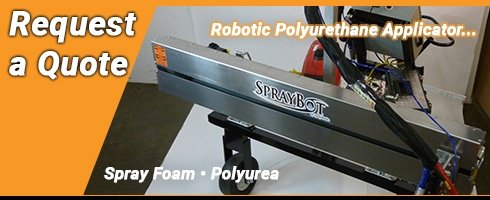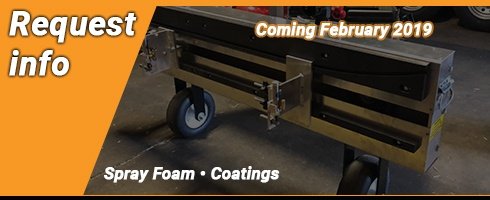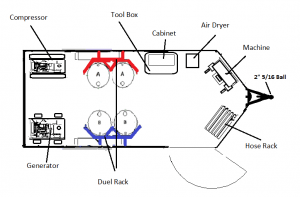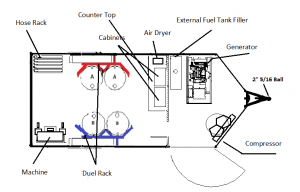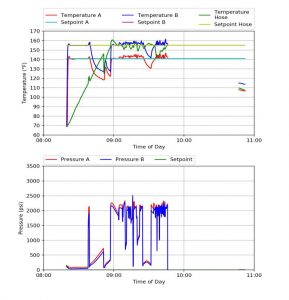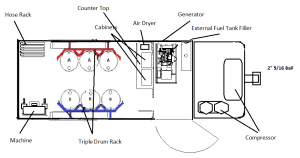Most new-age spray guns are equipped with a grease fitting to lubricate the gun after service. However, pre-greasing each and every par,t within the wet end of the spray gun during assembly, assures each part is properly greased – without relying solely on the zurk fitting.
Author Archive: John Davidson
Gun Cleaner for Minimizing Wear on Parts
Torching, picking, sanding, and wire brushing off the gun and related parts often does more damage than good. At best, it cleans the parts but accelerates service life by abrasive cleaning. Utilizing an effective gun cleaner to reduce excessive cleaning of parts is recommended. Generally, a quality gun cleaner can clean parts within 15-20 minutes when the gun cleaner is heated overnight at room temperatures.
Restoring an Iso Hose
After several years of service, iso will form a buildup within the hose. We recommend doing a thorough strip and rinse of these hoses to assure full flow performance. Order our SprayWorks Power Flush System to restore those aging iso hoses or when winterizing the system. You’ll be amazed at the amount of old cured materials that will come out.
Clean your screen filter
Materials entering the proportioning unit may require screening or filtering. Therefore, manufactures of the spray equipment commonly install y-strainers or filter housings on or near the machine to pre-screen the materials as they are transferred from the storage vessel prior to entering the proportioning unit. Proper cleaning or replacement of the screen filter must be completed daily or as needed to ensure proper material supply is achieved. Clogging and restriction of the screen filter may cause cavitation and/or poorly dispersed product known as off-ratio.
Continue reading
Apply spray better with this trick
Spray mechanics generally prefer a product that maintains a good level of sprayability for processing. Applying or processing spray foams just on the cooler side of the temperature processing spectrum can aid in maintaining a good pattern.
Continue reading
What Is Lean Construction & Why You Should Care
Whether by choice or the imposition of an economic downturn, those within the construction trade who have realized the benefits of implementing lean concepts are way ahead in the industry. The manufacturing industry first experienced measurable results, proving the effectiveness of applying lean principles. Global recession has been behind the spread of lean construction throughout the world.
Continue reading
4 Ways to Support National Safety Month
June is National Safety Month and as we are wrapping up the month, there are some key areas workers should be vigilant of while working in the heat – especially moving into some of the hotter months.
- Wear properly ventilated suits: Many contractors don’t know that when it comes to protective wear, they have options. Some suits are designed for working better in the heat. While it can be tempting to remove it, it’s important to keep protective equipment on. Not only is it required by OSHA, but protective wear keeps you from inhaling fumes and being exposed to splashing chemicals.We suggest using more ventilated suits. Tyvek suits are a great option. Many workers cut slits in the back under the armpit area to keep cooler. Some suits are designed to be more protective in chest area and even have expanded mesh fabric under armpits that helps to vent well. These types of suits are commonly used in the food industry and car painting industry, but are great for polyurethane as well. The next time you purchase a protective suit, look at the features to identify the best suit for the time of year you are spraying.
Test Your Side Seals and O-Rings for Proper Seating
After replacing the o-rings in your AP-2 Gun, it’s important to make sure they are sealing properly. In order to test if the side seals are seating properly and the o-ring is sealing, follow these steps:
With the safety on and the gun disconnected from the hose, hook an air hose onto the gun and pull on the trigger. This pulls the chamber back slightly which cuts the airflow coming out of the tip. The air should cease from blowing out of the tip and should only slightly exhaust at the vent near the handle and the air-motor. If the side seal, the o-ring around the side seal or the oring at the screen screw is not sealing the air will push out of the check valve seat.
Continue reading
How to Fix your Transfer Pump – Before you Replace it
PMC GHO, IPM OP series, Graco T2 Transfer Air motor performance
After use, the transfer pump air motor starts operating sluggish and leaks air. This is generally due to deforming (wear) of the upper reversing spring and the upper air valve gasket. You can notice the spring wear off in two ways. The first being the pump fails to return to the down stroke and secondly the pump will pause momentarily when reversing to the down stroke which appears as a cavitation type action. In this situation, hanging the spring is the best solution, but when in a pinch, stretching the spring to its near original length can get you through the day.
4 Ways to Maintain Your Rig
Maintaining your equipment seems like an obvious requirement, but keeping your rig up to snuff can seem tedious. Trust us, it’s not the most fun job, but it is a necessity to the life of your rig AND surprise surprise, your equipment too! In this article, our experts pulled together four of the most effective steps in maintaining your rig – aside from your standing oil changes, engine checks, and tire checks.
Continue reading

